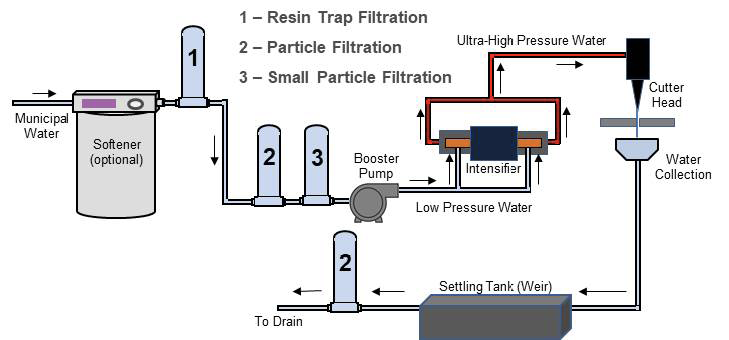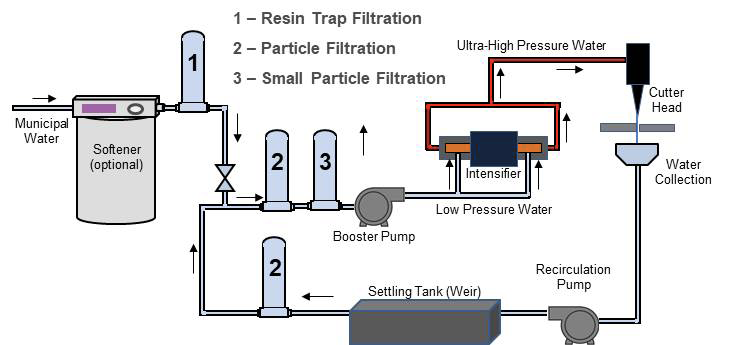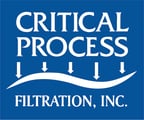There are many critical components in a waterjet cutting system. The quality of the water, especially the particle content of the water, has a significant impact on the life of those components.
The parts most impacted by water particulate levels are the plungers in the pressure intensifier. Each waterjet system has specifications for the maximum size of particles that the system can tolerate through the intensifier. Most system manufacturers will specify the filtration required to protect all system components.
Most waterjet cutting systems use municipal tap water as their source. The level of particulate matter can vary considerably with the source of the municipal water. Water with a surface source (river, lake, or reservoir) usually has higher particle content than water from an underground well. Understanding the source of the water and its particle load will help determine the number and type of filters required to safeguard the intensifier plungers.
Figures 1 and 2 show a direct feed water system and a water recirculation system. Both use the same filters. The recirculation system is used for machines/systems that cut hazardous materials that require recovery or disposal as hazardous waste (lead, beryllium copper, silver, etc). Direct feed systems are used on systems cutting non-hazardous materials (steel, aluminum, glass, etc).
Figure 1 - Direct Feed Water System

Figure 2 - Recirculating Water System

Removing Particles from Water
The figures above both show an optional softener where the water enters the system. As mentioned above, municipal water from a surface source usually has more particles than water from an underground well. However, water from a well usually has much higher dissolved minerals, including the “hardness” minerals calcium and magnesium. To avoid calcium or magnesium oxide deposits on or in the cutting head or other components, a softener is used.
Resin Trap Filters (Housing 1)
The core of a water softener is a resin bed (plastic beads). Resin can break down over time and particles can escape resin vessels, so filters are used to trap the particles and prevent their contamination of downstream processes (housings marked “1”). Standard depth filters are most often used for this function.
Particle Filters (Housing 2)
Depending on the particle load of the water, removing particles larger than those allowed by the system manufacturer may be done using a single filter or multiple filters. Water with a higher particle load (such as water from a surface source) will often require a series of 2 or more filters to remove particles and have an acceptable useful life before plugging.
The figures show systems with 2 filters. The initial filter is in place to capture particles larger than those the final filter will be asked to remove. For example, if the final filter is a 0.45-micron filter, the operator may choose to use the 1-micron filter as the first filter step. If the final filter is a 1-micron filter, a 5-micron filter may be used here. The choice is entirely based on particle loads and the recommendation of the system manufacturer on the maximum particle size allowed. Most operators use standard depth filters for this step.
Small Particle Filters (Housing 3)
The most important filter is the final filter. This is the last barrier keeping harmful particles from the intensifier and other components. It is useful to consider the filters in housings 2 and 3 as a single functioning unit. If designed properly, the filters will work together to capture all of the particles required using the fewest filters at the lowest cost.
The type of filter used as the final filter in the train will vary based on the maximum particle size allowed. If the maximum particle size is smaller than 1 micron, membrane filters are usually used because of their high removal efficiency for submicron-size particles. If the maximum particle size allowed is 1 micron or larger, then high-efficiency pleated depth filters may be used, though their efficiency is not as high as membrane filters with larger pore sizes such as polyethersulfone (PES) or nylon membrane with 0.8 or 1.2-micron ratings.
Filter Options
Depth filtration products such as Critical Process Filtration Melt-Blown Polypropylene or Nano-Spun Polypropylene cartridges are commonly used for particle removal. These products will hold a large quantity of silt or sediment before requiring replacement.
Depending on the type and number of particles in the source water, an economical alternative to standard depth filters may be pleated depth media filters. Pleated filtration products, such as pleated polypropylene depth filters, have several times more surface area than melt-blown or nano-spun depth filters and will hold a much higher quantity of sediment or silt. Pleated filters do generally cost more, but the increased life in high-particle-load applications and labor savings from reduced filter change frequency may make pleated filters economical.
For small particle removal, filters made using polyethersulfone (PES) or nylon membrane are the most efficient option. Membrane filters are “absolute” rated and will remove virtually all particles larger than the pore size rating.
